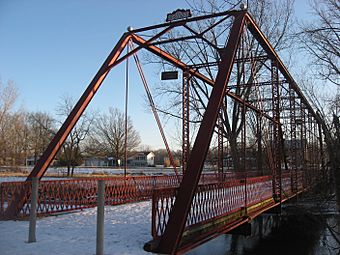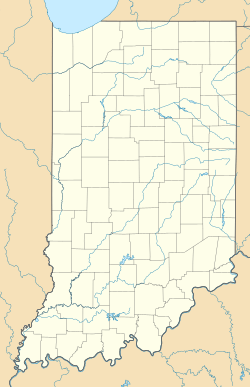Chinworth Bridge facts for kids
Quick facts for kids |
|
|
Chinworth Bridge
|
|

Northern portal and western (downstream) side of the Chinworth Bridge, which spans the Tippecanoe River west of Warsaw in Harrison and Wayne Townships of Kosciusko County, Indiana, United States.
|
|
| Nearest city | Junction of Old U.S. Route 30 and Road 350 W west of Warsaw, across the Tippecanoe River, Harrison Township and Wayne Township, Kosciusko County, Indiana |
|---|---|
| Area | less than one acre |
| Built | 1897 |
| Built by | Bellefontaine Bridge & Iron Company |
| Architectural style | Pratt through truss |
| NRHP reference No. | 96001546 |
| Added to NRHP | January 2, 1997 |
The Chinworth Bridge is a special landmark in Kosciusko County, Indiana. It's the only Pratt through truss bridge still standing in the area. It's also one of the few bridges built by the Bellefontaine Bridge and Iron Company that you can still see today.
Long ago, people crossed the Tippecanoe River at a shallow spot called a ford, right near where the bridge is now. A famous old road, the Yellowstone Trail, also passed by on the south side of the river. There's even a marker there to remember it.
In 1884, people wanted a new bridge to connect Warsaw with towns like Atwood and Etna Green. The bridge was built on land owned by Robert Chinworth. Captain David Braden, working for the Bellefontaine Bridge and Iron Company, agreed to build a 140-foot (about 43-meter) bridge. It cost $2520 and opened in August 1897.
By 1924, cars were bigger and faster. The Chinworth Bridge wasn't wide enough for the new U.S. 30 highway. So, a new road was built that went around it. The Indiana State Highway Commission even created a rest area next to the old bridge.
In 1975, U.S. 30 was made even bigger with four lanes. At that time, the Chinworth Bridge was closed to all cars. In July 1975, the Kosciusko County Historical Society took over the rest park and the bridge. They officially named the bridge a historic landmark on July 6, 1975.
Contents
Bridge Design: What Makes It Special?
The Chinworth Bridge was built by the Bellefontaine Bridge and Iron Company from Ohio. It's a 140-foot (about 43-meter) long Pratt through truss bridge. This type of bridge uses a special design to make it strong.
How the Truss Works
The bridge's main structure, called the truss, has eight sections. Each section is 17.5 feet (about 5.3 meters) long. These sections rest on strong stone supports called abutments. The southern support has been changed a bit over the years.
The truss has straight top and bottom parts, which are 24 feet (about 7.3 meters) apart. It also has slanted posts at each end. Diagonal rods are designed to handle pulling forces, especially at the ends of the bridge. There are also smaller rods with special adjusters called turnbuckles to add extra strength.
Keeping the Bridge Strong
To make the bridge even stronger, there's bracing at the top and bottom. To stop the bridge from swaying, a round iron rod runs diagonally from one side to the other.
The bridge deck, where cars used to drive, is supported by strong I-shaped beams. Wooden planks on top of these beams form the 14-foot (about 4.3-meter) wide driving surface. In 1927, a black, tar-like coating was added to the wood. There's also a metal guardrail along each side of the deck. The bridge allows for a clearance of 19 feet (about 5.8 meters) underneath.
Why the Chinworth Bridge is Important
The Chinworth Bridge is a great example of a Pratt through truss bridge. This design was created in 1844 by Caleb and Thomas Pratt. In a Pratt truss, the vertical (up-and-down) parts are pushed together, and the diagonal (slanted) parts are pulled. This type of bridge was very common in the early 1900s.
Images for kids






